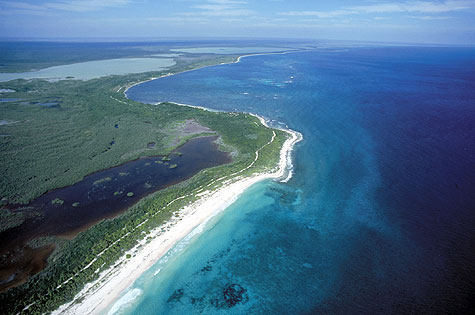The massive Sian Ka'an Biosphere refuge (above) on Mexico's Yucatan Peninsula is proving a big drawcard for visitors.
Going wild in Mexico doesn't have to mean a tequila-fueled beach vacation dancing on tabletops surrounded by carousing college kids on spring break. In fact, the big party destination of Cancun is just a short distance from lush parks hosting wildlife of another sort.
Neon pink flamingos, howler monkeys, brilliant toucans and mysterious sea turtles are just a few of the locals you can meet by trading la vida loca for a more nature-friendly trip.
Cancun and its surrounding area of the Riviera Maya are Mexico's top destination for international travelers, drawing more than 3.5 million visitors a year.
The beach was the lure for the first visit my wife and I took six years ago. But since then, we've returned to explore the Northern Hemisphere's largest barrier reef off the coast, natural springs pocking the Yucatan Peninsula, mangrove swamps, salt marshes and thick jungle.
Much of the Yucatan is a flat limestone slab, topped with low jungle and scrub. There are no real rivers; the heavy seasonal rain seeps into sinkholes - known locally as cenotes - that have eroded over the millennia into the porous stone. The fresh water travels underground and percolates into the sea from natural springs.
The woods, cenotes and waters off the coast host a riot of colorful animals. Great blue herons, anteaters, the rust rump tarantula, giant iguanas, ocelots, manatees and countless other animals make their home in the region.
Families or other travelers who want to heed the call of the wild can check out the three eco-parks of Xcaret, Xel-Ha and Tres Rios. All are just a short ride away from the impressive resorts at Cancun, Playa del Carmen and the rest of the Riviera Maya.
Xcaret is the most developed. It's a bit like a big water park in the United States - but with a walk-through butterfly pavilion. You can also follow a narrow river from a spring out to the Caribbean and swim with dolphins and manatee.
Xel-Ha is the middle of the pack. It feels less engineered and is centered around a huge lagoon where fresh spring water mingles with the saltwater and teems with electric-colored fish. Xel-Ha also offers chances to swim with the dolphins.
Tres Rios is our favorite. It is far less developed than the other two parks. You can kayak in the surf or canoe solo through the mangroves (no crocodiles as far as we could see), take a boat out to snorkel on the reef or ride horses.
More adventurous tourists stray a bit farther and visit the gem of the Sian Ka'an Biosphere Refuge. The UNESCO world heritage site sprawls across about 530,000 hectares and includes everything from offshore coral reefs in to the beaches, lagoons, cenotes and low tropical forests.
It's a good idea to book a trip through the local tourism office as the roads are tricky. We took a day-trip with a fly-by-night tour operator we found through our hotel in Playa del Carmen and ended up being chauffeured by a German tourist excited to drive an American jeep.
We spent a day in the biosphere, slowly making our way along rutted roads through the jungle to a boat that ferried us through mangrove-filled marshes.
We spent a good 20 minutes circling a mangrove island packed with two species with memorable names - Magnificent Frigatebirds and Brown Boobies. Flamingos prompted our latest trip to Mexico. I'd never seen a live example of the model for countless tacky lawn ornaments. So we decided to go big and see hundreds of them at once.
We centered the trip in the city of Merida in the northwest part of the Yucatan Peninsula. Two of the best spots for flamingo-watching are the villages of Celestun, which we chose, and Rio Lagartos.
Tens of thousands of flamingos spend a good part of the year in these two spots, socializing, feeding and mating. They gain their distinctive color from the shrimp and other crustaceans they spend all day hunting in shallow water.
You can catch a flamingo tour either from the beach or by the side of the bridge as you first enter town. We joined a French couple for a half-day tour by boat from the beach for about US$20 each.
When we reached the flamingos, our guide killed the motor and we coasted within 100 meters of a group of about 75 of the birds. As the boat rocked gently, it was a bit of a shock to hear the elegant birds chatting. They sound almost exactly like ducks quacking.
Locals realize the importance of the birds. Increasingly Mexico sees eco-tourism as a way to steer jobs and investment to some impoverished rural areas.
"We want to change the perception of Mexico that it's just sun and beach," said Eduardo Chaillo, director of the Mexico Tourism Board's Strategic Business Unit for the US and Canada.
So Mexican tourism officials are working with National Geographic and tour operators to introduce the world to the country's natural spots.
"But we cannot risk these precious places by promoting them massively," said Chaillo.
For now, it appears tourists aren't exactly swarming the Yucatan's wild places. So, whether it's a quick break from the beach or the theme of your trip, Mexico's wildlife is waiting.
(Shanghai Daily by Fritz Faerber January 28, 2008)


